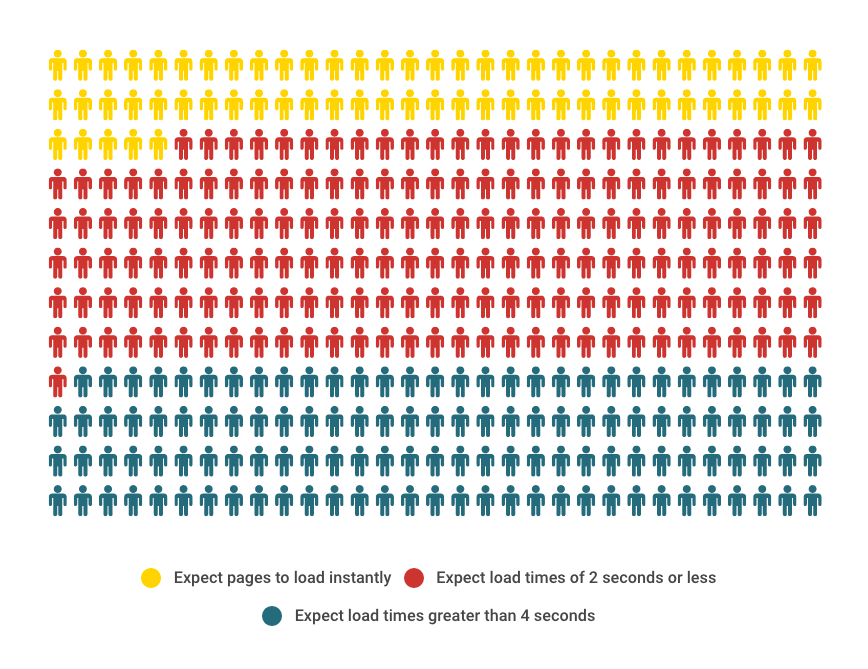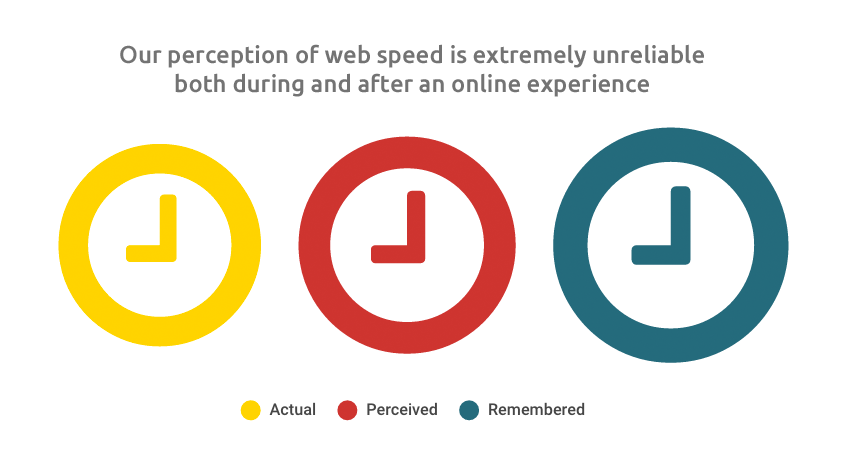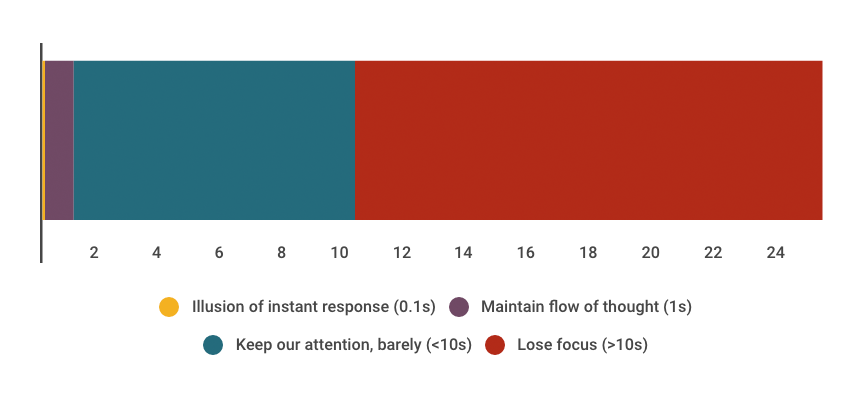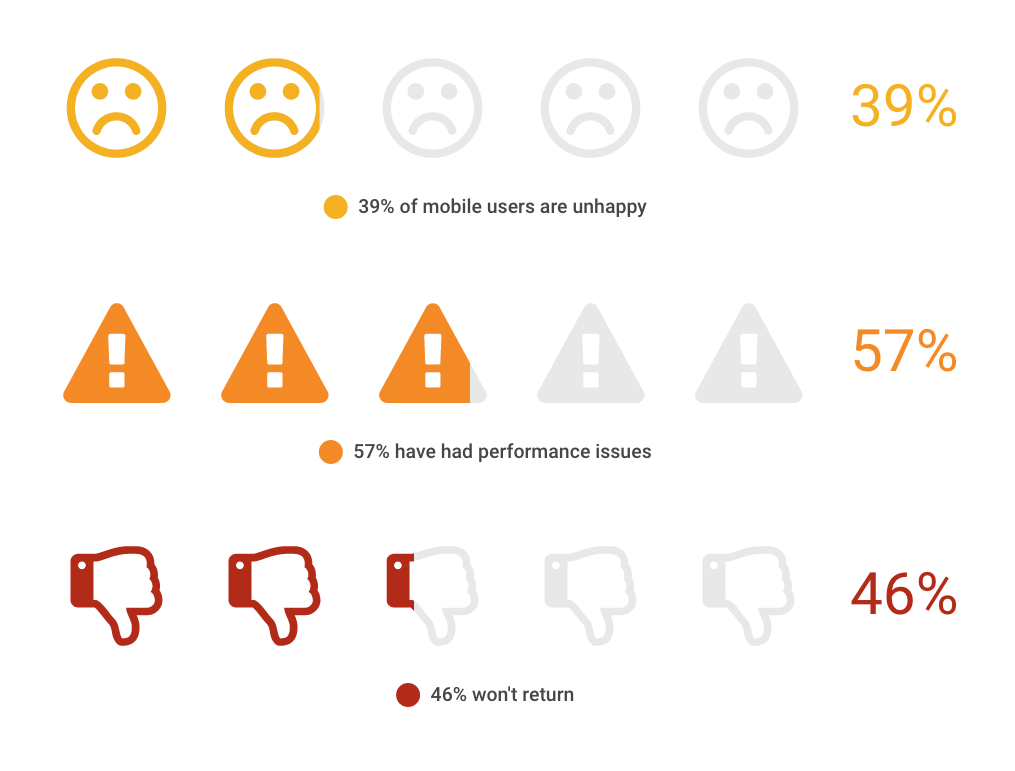Chapter 1. The Psychology of Web Performance
Before we dive into case studies, it’s important to first understand the roots of our craving for lightning-fast online experiences.
Over the past 40-something years, there’s been a great deal of fascinating research into how human beings engage with technology. These studies—many of which have findings that have persisted over the years—demonstrate that we don’t just want our technology to be fast, but at a deep neurological level, we need it to be fast. And because these needs are deeply rooted in our neural wiring, they’re unlikely to change, no matter how much we might wish they could.
Fast Websites and Apps Create Happier Users
When users are happy as a result of a fast website, they’re more likely to follow calls to action telling them to register, download, subscribe, request information, or purchase.
Unhappy users—those who experience a mere 2-second slowdown in how a web page loads—simply do less. They make almost 2% fewer queries, they click 3.75% less often, and they report being significantly less satisfied with their overall experience. Worse, they tell their friends about their negative experience.
A UK survey of 1,500 web users1 found that:
- 71% of people surveyed feel regularly inconvenienced by slow websites (Figure 1-1).
- Over 30% report that their performance-related stress or anger has increased, not decreased, over the years.
- 50% believe websites have either not improved in speed or have become slower over the past several years.
- 78% felt some kind of negative emotion due to slow or unreliable websites.
- Women (34%) are slightly more likely than men (27%) to report feeling stress or anger over slow web performance.
- 44% of users say that slow online transactions make them unsure about the success of the transaction.
- 42% of men and 35% of women have decided not to use a company again as a result of experiencing a slow website.

Figure 1-1. Results of the “Need for Speed” survey conducted by 1&1 Internet
How Fast Do We Expect Web Pages to Be?
We expect a lot from our online experiences. We want websites to be easy to use, we want them to be safe, and we want them to be fast. And when it comes to site speed, our demands are relentless. In 2006, the average online shopper expected pages to load in 4 seconds or less.2 Today, 49% expect load times of 2 seconds or less, and 18%—one out of five—expect pages to load instantly (Figure 1-2).3
This shouldn’t come as a surprise to anyone who’s been tracking decades’ worth of research into how humans use technology. (If you haven’t been doing this, that’s OK: I’ve got your back.) In lab test after lab test, going back as far as Robert B. Miller’s classic research on human responses to computer performance,4 studies have found that people are—and always have been—most comfortable, most efficient, and most productive with response times of less than 2 seconds.

Figure 1-2. 49% of Internet users expect web pages to load in 2 seconds or less (Akamai)
It’s tempting to label ourselves picky and impatient, but we’re not. There’s a wealth of research into what happens to us at a neurological level when we’re forced to deal with slow or interrupted processes. It isn’t pretty.
Our Need for Web Speed
Our perception of time varies according to many factors, including (but certainly not limited to) our age, our location, our emotions, and assorted external stimuli.
Not surprisingly, this inconsistency applies to our online experiences as well:
- The average web user perceives load times as being 15% slower than they actually are (Figure 1-3).
- Later, when recalling the experience, they remember load times as being 35% slower.5
- The average person believes they spend 9 minutes per day waiting for slow websites. This translates to two full days every year.6 (I’m skeptical about this one. I spend a lot of time online, and even I don’t believe I spend two days a year waiting for pages to load. But this stat is an interesting gauge of how people feel about the Web, even if it’s not entirely accurate.)
- Adding indicators like spinners and progress bars can trick us into believing that pages are up to 10% faster than they actually are.7

Figure 1-3. The average web user perceives load times as being 15% slower than they actually are; later, they recall the experience as being 35% slower
While what we say we expect from online experiences is inaccurate and highly variable, how we actually respond to different page speeds is much more consistent—and has been so for several decades.
Usability expert Jakob Nielsen has stated8 that human responses to poor load times are based on two aspects of how our brains function:
- Our poor short-term memory
- Information stored in short-term memory decays quickly.
- Our need to feel in control
- Being forced to wait makes us feel powerless and frustrated.
According to Nielsen, 0.1 seconds gives us the illusion of instantaneous response, 1 second keeps our flow of thought seamless, and 10 seconds is enough to keep our attention—barely. After 10 seconds, our minds wander, making it harder to get back on task once a page finally loads (Figure 1-4).

Figure 1-4. According to research that has persisted since 1993, 0.1 seconds gives us the illusion of instantaneousness; after 10 seconds, we lose focus
The Internet may change, and web pages may grow and evolve, but user expectations are constant. The numbers about human perception and response times have been consistent for more than 45 years. These numbers are hard-wired. We have zero control over them. They’re consistent regardless of the type of device, application, or connection we’re using at any given moment.
Why Are We Impatient? Because Neuroscience
This section is for all the hardcore psychology geeks out there. If this isn’t you, that’s OK. Skip it. The main point I want you to take away is the knowledge that our impatience is an indelible part of our incredible human circuitry.
If you’re still reading, then you may be interested in knowing that, at any given moment, there are three types of memory processing at work in your brain:
- Sensory memory
- Short-term memory
- Working memory
(There’s also long-term memory, but it doesn’t really come into play here.)
Sensory memory
Every time you see something, this visual information is taken in by photoreceptor cells in your eyes and sent to the occipital lobe in your brain. This is your iconic memory. It’s just one of your three types of sensory memories (the other two govern sound and touch).
People have been studying how iconic memory works for almost 300 years. In one of the earliest studies,9 a glowing coal was attached to the wheel of a cart. The wheel was spun faster and faster until observers perceived an unbroken circle of light. The study concluded that the glowing coal had to perform a complete cycle in 100 milliseconds or less in order to create the illusion of a fiery circle. This early study identified the phenomenon we now call “persistence of vision,” which is predicated on the fact that our iconic memory holds on to visual information for about 100 milliseconds. After that, the “memory store” runs out and the iconic memory needs to be refreshed with new visual information.
This number has remained consistent throughout the centuries. Interestingly, and perhaps not coincidentally, 100 milliseconds is Google’s stated goal when it comes to page load times.
Iconic memory, along with the other two types of sensory memory, is primitive. We can’t consciously choose what information is stored in it, and we can’t will it to last longer. If we could, we’d probably go insane or accidentally walk in front of a bus.
Some sensory memory does stick, of course, provided it’s used quickly and eventually consolidated into your long-term memory.
Short-term memory and working memory
If our sensory memory’s role is to provide comprehensive information on our entire sensory experience, it’s our short-term memory’s job to extract the relevant bits and throw them into the hopper of our working memory. Your short-term memory can store information for 10–15 seconds, at most—just enough time for your working memory to process, manipulate, and control it.
So the goal in getting page load times down to 100 milliseconds is to keep information from falling through the cracks in our iconic memory, while also giving our short-term and working memory ample time to do all the parsing they need to do before they start losing information.
What Is “Flow” and How Does It Relate to How We Use the Web?
For hundreds of thousands of years, human beings have evolved to perform actions in beautiful, sequential flows. Our day-to-day tasks—building a fire, hunting antelope, baking bread, milking a cow—have been comprised of a series of minute actions that flow more or less seamlessly into the next.
In Finding Flow: The Psychology of Engagement with Everyday Life (Basic Books, 1998), noted psychology researcher Mihaly Csíkszentmihályi observed that people who perform seamless, sequence-based activities on a regular basis are happier than people who don’t. He coined the term “flow” to describe this state of being.
It’s only in the past 40 years, with the advent of computers, that we’ve imposed a new set of demands on our brains. As most of us are painfully aware, instead of offering a series of smoothly sequential actions, computer use is characterized by lag, downtime, and restarts. Our flow-oriented brains simply aren’t wired to deal with the fits and starts of human–computer interaction.
In my travels, I encounter people who are skeptical about the impact of lag, downtime, and restarts on productivity and other key performance indicators. The argument I hear is that most people do, in fact, adjust to poor performance.
As it turns out, these people may be somewhat correct, but they may also be focusing on the wrong part of the picture.
Questioning Our Assumptions: Do Delays Really Hurt Productivity?
In a 1999 study into workplace interruptions,10 groups of workers were subjected to various disruptions in the course of their day-to-day responsibilities. They were then measured in terms of both their productivity and their self-reported state of mind. While this study focused on general workplace interruptions, with only some attention given to human–computer interaction, there were some fascinating findings that are arguably relevant to web performance:
- Finding 1: Participants developed strategies that let them deal effectively with interruptions and maintain their productivity
- This research suggests that, at least for some workers in some environments, not only do they learn how to cope with interruptions, they may even strive to overcompensate for their potential performance decline.
- Finding 2: However, this coping mechanism is achieved at the expense of higher psychological costs
- Cumulatively, interruptions had a negative impact on emotions and well-being. In addition, participants ultimately needed to increase the amount of effort required to perform the same tasks.
- Finding 3: Over time, interruptions affected participants’ ability and willingness to resume work and take on new tasks
- Interruptions seemed to have a cumulative effect. When the number of interruptions grew, the resumption time (i.e., the time needed to restart the task) became disproportionately longer. The participants seemed to lose motivation and develop mental fatigue.
What Does This Mean in Web Performance Terms?
When dealing with application delays, it’s possible that people can develop coping strategies that allow them to maintain productivity in the short term. But the missing ingredient here is flow. And without flow, eventually our sense of motivation and well-being suffers.
It’s also important to remind ourselves that application performance is just one part of the greater world. Our everyday lives are filled with events—from sitting in traffic to standing in line at the grocery store—that challenge our need for flow. Poor web performance is just one problem, but for those of us who spend much of our work and personal time online, it’s extra friction in an already friction-filled world. Its effects are cumulative, as most of us aren’t capable of compartmentalizing our stress.
Web Stress: It’s a Thing
When websites perform poorly, we react badly (there’s even some research that suggests using slow websites increases our blood pressure!). This is not surprising given what we now know about our deep craving for flow.
In 2011, CA Technologies commissioned Foviance, a customer experience consultancy, to conduct a series of lab experiments at Glasgow Caledonian University.11 The participants wore an EEG (electroencephalography) cap to monitor their brainwave activity while they performed routine online transactions. Participants completed tasks using either a 5 MB web connection or a connection that had been artificially slowed down to 2 MB.
Brainwave analysis from the experiment revealed that participants had to concentrate up to 50% more when using websites via the slower connection. When asked what they liked most and least about the websites they used during the study, participants frequently cited speed as a top concern:
The website was very slow, so it took a really long time to load the book preview.
What I liked least about the site is its speed.
The study also found that people were most likely to experience the greatest levels of stress during two points in the transaction process:
- Search
- Finding and selecting products
- Checkout
- Entering personal information and concluding the sale
Intuitively, this makes sense. Searching for an item already comes with an inherent amount of stress, as most of us are concerned with finding the right item at the best possible price. And the checkout process—when we hand over our personal and credit card information—is fraught with a certain amount of stress as well. Add page slowdowns to the mix and it’s easy to understand why the online shopping experience can become unpleasant.
Mobile Users Feel Web Stress, Too
Mobile users are unhappy, too. According to an Akamai survey,12 39% of mobile users are dissatisfied with their online experiences, citing page slowdowns and site crashes as their top two complaints. More than half have experienced problems when using their phones or tablets, and 46% say they won’t return to a site that performs badly (Figure 1-5).

Figure 1-5. According to Akamai research, many mobile users are dissatisfied with the performance of the sites they visit
What Does This Dissatisfaction with Mobile Performance Look Like at a Neuroscientific Level?
Based on the desktop neuroscientific research conducted by CA Technologies, Radware conducted a similar study in 2013, this time focusing on users of mobile devices.13 (Disclosure: I worked for Radware at the time and directed this research.) Radware’s study involved using a groundbreaking combination of eyetracking and electroencephalography (EEG) technologies to monitor neural activity in a group of mobile users who were asked to perform a series of online transactions via mobile devices.
In the study, participants were asked to complete standardized shopping tasks on four ecommerce sites while using a smartphone. Some participants were served pages at normal speeds over WiFi, while others were served pages at a consistently slowed-down speed (using software that created an artificial 500-millisecond network delay). The participants didn’t know that speed was a factor in the tests; rather, they believed that they were participating in a generic usability/brand perception study.
Some highlights of the study’s findings:
- Users experienced frustration peaks of up to 26% at critical points.
- Like the CA Technologies study, frustration peaks were most common during the browsing and checkout phases.
- Faster pages correlated with increased user engagement (that’s a good thing!).
- Slowness affected the entire perception of the brand, even nonperformance aspects of the site such as content, design, and navigation.
- Users experienced “web stress” even under ideal mobile browsing conditions.
Takeaway
There’s a fascinating disconnect between what we say we want and what, deep down, we really need from our online experiences. Over the past dozen or so years, user surveys have revealed that what we claim to want changes over time—from 8-second load times back in 1999 to 4 seconds in 2006 to around 2 seconds today. If we were to believe these surveys, then we’d conclude that we’re an increasingly hasty, impatient species. We might be tempted to judge (or pity) ourselves as victims of our frantic modern lives.
But neuroscientific research—which studies how we actually think, not how we believe we think—tells a very different story. Over the decades, researchers have reproduced the same results: that, by and large, we function at our happiest best when our websites and apps (and technology in general) respond in fractions of a second. We may learn how to adapt to slower response times, but this adaptation will always (or at least for the foreseeable future) be awkward and uneasy.
1 “Need for Speed,” 1&1 Internet. 2011.
2 Akamai Technologies and Jupiter Research, 2006.
3 “2014 Consumer Web Performance Expectations Survey,” Akamai Technologies.
4 Robert B. Miller, “Response Time in Man–Computer Conversational Transactions,” 1968.
5 Stoyan Stefanov, “Psychology of Performance,” 2010.
6 “Need for Speed,” 1&1 Internet, 2011.
7 Colin Barras, “Visual tricks can make downloads seem quicker,” New Scientist, 2010.
8 Jakob Nielsen, “Website Response Times,” June 21, 2010.
9 Alan D. Baddely, Human Memory: Theory and Practice, 1990.
10 Mary Czerwinski, Eric Horvitz, and Susan Wilhite, “A Diary Study of Task Switching and Interruptions,” Microsoft Research, 1999.
11 “Web Stress: A Wake Up Call for European Business,” Foviance (for CA Technologies), February 2010.
12 “2014 Consumer Web Performance Expectations Survey,” Akamai Technologies.
13 “Mobile Web Stress: The Impact of Network Speed on Emotional Engagement and Brand Perception,” Radware, 2013.
Get Time Is Money now with the O’Reilly learning platform.
O’Reilly members experience books, live events, courses curated by job role, and more from O’Reilly and nearly 200 top publishers.

